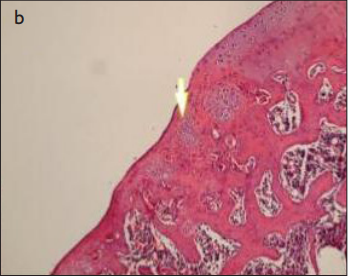Objective: We used biomimetic scaffolds, chondral scaffolds, and microfractures to repair experimentally created osteochondral defects in rat knees and then compared the results of each method.
Materials and Methods: We used a total of 56 female Wistar albino rats. The rats were grouped into 4 groups, with 14 rats each: biomimetic scaffold, chondral scaffold, microfracture, and control groups. Cylindrical full-thickness osteochondral defects 2.5 mm in diameter and 2 mm in depth were drilled into the right knees with the rats under general anesthesia. The knees of all rats were operated again after 4 weeks. Biomimetic and chondral scaffolds were classified into two groups. Microfractures 0.5 mm in diameter and 0.8 mm in depth were created in the rats of the microfracture group. The control group received no treatment. All the rats were observed for 6 weeks and then sacrificed, with samples subjected to macroscopic and histopathological examinations.
Results: The macroscopic and histopathological results in the biomimetic scaffold group differed significantly from those of the other treatment groups (p<0.05). When we compared the 3 treatment groups, the results of the chondral scaffold group were better than those of the microfracture group. The results of the microfracture group were somewhat better than those of the control group, but the result was not statistically significant (p>0.05).
Conclusions: Nanocomposite multilayer biomimetic scaffolds were better than chondral scaffolds and microfractures when used to treat osteochondral defects.
Cite this article as: Solak K, Yucel I, Karaduman ZO, et al. Histological Comparison of Nanocomposite Multilayer Biomimetic Scaffold, a Chondral Scaffold, and Microfracture Technique to Repair Experimental Osteochondral Defects in Rats. Eurasian J Med 2020; 52(2): 145-52.

.png)
_In%20Progress-1%20(1)_page-0001.jpg)

.png)
.png)
